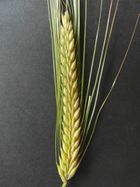Two-row: Difference between revisions
Jump to navigation
Jump to search
Uncle Jesse (talk | contribs) No edit summary |
Uncle Jesse (talk | contribs) (Adding image) |
||
| Line 1: | Line 1: | ||
[[File:2-Row-Ear.jpg|thumb|140px|right|Ear of two-row barley]] | |||
Two-row barley (''Hordeum distichum''), is a form of barley which is the most common [[grain]] in [[beer]] and [[scotch]]. It is also used in most [[Whisky|whiskies]]. Two-row barley is the oldest form, wild barley having two-rows as well. Two-row barley has a lower protein content than six-row barley but a higher [[enzyme]] content. High protein barley is best suited for animal feed or malt that has a large adjunct content. Two-row barley is best suited for pure malts. In two-row barley only one flower is fertile. | Two-row barley (''Hordeum distichum''), is a form of barley which is the most common [[grain]] in [[beer]] and [[scotch]]. It is also used in most [[Whisky|whiskies]]. Two-row barley is the oldest form, wild barley having two-rows as well. Two-row barley has a lower protein content than six-row barley but a higher [[enzyme]] content. High protein barley is best suited for animal feed or malt that has a large adjunct content. Two-row barley is best suited for pure malts. In two-row barley only one flower is fertile. | ||
Revision as of 21:45, 17 September 2017
Two-row barley (Hordeum distichum), is a form of barley which is the most common grain in beer and scotch. It is also used in most whiskies. Two-row barley is the oldest form, wild barley having two-rows as well. Two-row barley has a lower protein content than six-row barley but a higher enzyme content. High protein barley is best suited for animal feed or malt that has a large adjunct content. Two-row barley is best suited for pure malts. In two-row barley only one flower is fertile.
